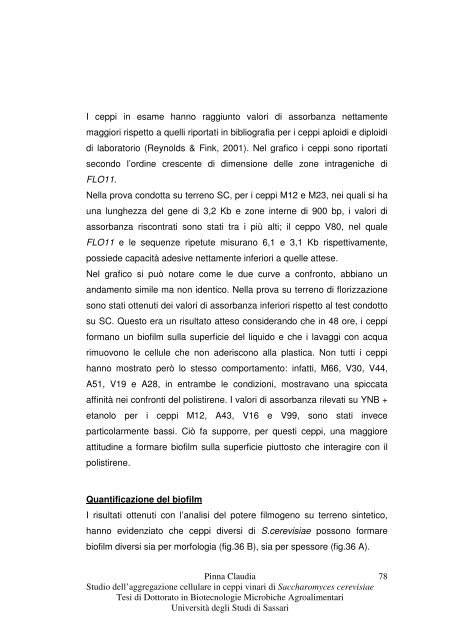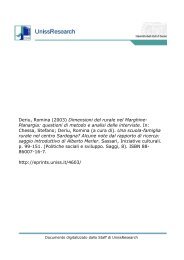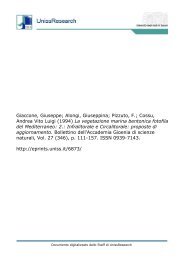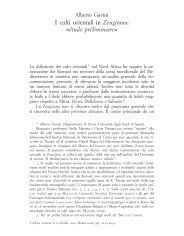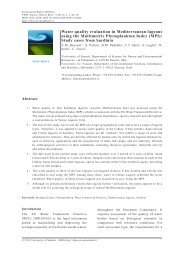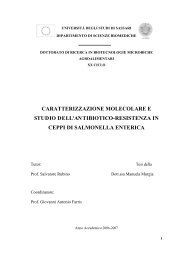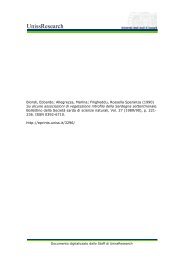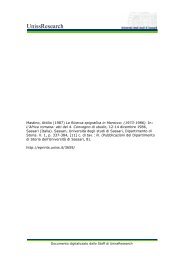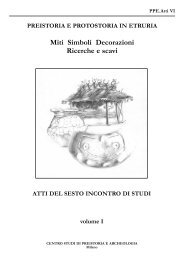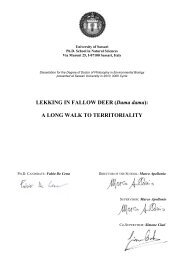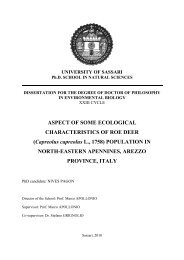Studio dell'aggregazione cellulare in ceppi vinari di Saccharomyces ...
Studio dell'aggregazione cellulare in ceppi vinari di Saccharomyces ...
Studio dell'aggregazione cellulare in ceppi vinari di Saccharomyces ...
You also want an ePaper? Increase the reach of your titles
YUMPU automatically turns print PDFs into web optimized ePapers that Google loves.
I <strong>ceppi</strong> <strong>in</strong> esame hanno raggiunto valori <strong>di</strong> assorbanza nettamente<br />
maggiori rispetto a quelli riportati <strong>in</strong> bibliografia per i <strong>ceppi</strong> aploi<strong>di</strong> e <strong>di</strong>ploi<strong>di</strong><br />
<strong>di</strong> laboratorio (Reynolds & F<strong>in</strong>k, 2001). Nel grafico i <strong>ceppi</strong> sono riportati<br />
secondo l’ord<strong>in</strong>e crescente <strong>di</strong> <strong>di</strong>mensione delle zone <strong>in</strong>trageniche <strong>di</strong><br />
FLO11.<br />
Nella prova condotta su terreno SC, per i <strong>ceppi</strong> M12 e M23, nei quali si ha<br />
una lunghezza del gene <strong>di</strong> 3,2 Kb e zone <strong>in</strong>terne <strong>di</strong> 900 bp, i valori <strong>di</strong><br />
assorbanza riscontrati sono stati tra i più alti; il ceppo V80, nel quale<br />
FLO11 e le sequenze ripetute misurano 6,1 e 3,1 Kb rispettivamente,<br />
possiede capacità adesive nettamente <strong>in</strong>feriori a quelle attese.<br />
Nel grafico si può notare come le due curve a confronto, abbiano un<br />
andamento simile ma non identico. Nella prova su terreno <strong>di</strong> florizzazione<br />
sono stati ottenuti dei valori <strong>di</strong> assorbanza <strong>in</strong>feriori rispetto al test condotto<br />
su SC. Questo era un risultato atteso considerando che <strong>in</strong> 48 ore, i <strong>ceppi</strong><br />
formano un biofilm sulla superficie del liquido e che i lavaggi con acqua<br />
rimuovono le cellule che non aderiscono alla plastica. Non tutti i <strong>ceppi</strong><br />
hanno mostrato però lo stesso comportamento: <strong>in</strong>fatti, M66, V30, V44,<br />
A51, V19 e A28, <strong>in</strong> entrambe le con<strong>di</strong>zioni, mostravano una spiccata<br />
aff<strong>in</strong>ità nei confronti del polistirene. I valori <strong>di</strong> assorbanza rilevati su YNB +<br />
etanolo per i <strong>ceppi</strong> M12, A43, V16 e V99, sono stati <strong>in</strong>vece<br />
particolarmente bassi. Ciò fa supporre, per questi <strong>ceppi</strong>, una maggiore<br />
attitud<strong>in</strong>e a formare biofilm sulla superficie piuttosto che <strong>in</strong>teragire con il<br />
polistirene.<br />
Quantificazione del biofilm<br />
I risultati ottenuti con l’analisi del potere filmogeno su terreno s<strong>in</strong>tetico,<br />
hanno evidenziato che <strong>ceppi</strong> <strong>di</strong>versi <strong>di</strong> S.cerevisiae possono formare<br />
biofilm <strong>di</strong>versi sia per morfologia (fig.36 B), sia per spessore (fig.36 A).<br />
P<strong>in</strong>na Clau<strong>di</strong>a<br />
<strong>Stu<strong>di</strong>o</strong> dell’aggregazione <strong>cellulare</strong> <strong>in</strong> <strong>ceppi</strong> v<strong>in</strong>ari <strong>di</strong> <strong>Saccharomyces</strong> cerevisiae<br />
Tesi <strong>di</strong> Dottorato <strong>in</strong> Biotecnologie Microbiche Agroalimentari<br />
Università degli Stu<strong>di</strong> <strong>di</strong> Sassari<br />
78


